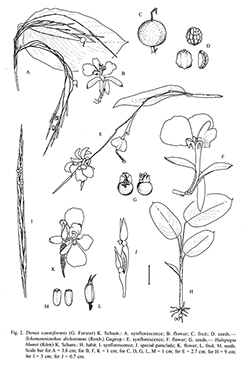e-Flora of Thailand
Volume 9 > Part 2 > Year 2008 > Page 125 > Marantaceae > Donax
Donax canniformis (G.Forster) K.Schum.wfo-0000398239
Bot. Jahrb. 15(4): 440. 1893; W.Delin & H.Kennedy, Fl. China 24: 381. 2000; P.H.Hô, Câyco Viêtnam 3: 466, fig. 9566. 2000.— Thalia canniformis G.Forst., Prod. 1. 1780.— Actoplanes canniformis (G.Forst.) K.Schum. in Engl., Pflanzenr. IV. 48: 34–35. 1902. Fig. 2: A–D.
Accepted Name : This is currently accepted.
Synonyms & Citations :
Description : Widely branched plant, 3–5 m high. Sheath up to 18 cm long; green, glabrous; pulvinus 1–2 cm long, green, glabrous; lamina ovate-elliptic, acuminate, base broadly cuneate, 15–31.5 by 7.5–18 cm, green above, pale below, glabrous with hairs on either side of the prominent midrib. Inflorescence profusely branched, lax, terminal on an aerial branch, composed of up to 10 major branches, each subtended by ca 3.5–6.5 cm long brown, papery bract and bearing a bicarinate prophyll, 2–6 cm long, just above its base; distal internode of the inflorescence branch elongate, 1.6–1.8 cm long; each node with a brown, papery, curled bract forming a tube, ca 3 cm long, subtending either a prophyllate branch or a special paraclade with 1 flower-pair; primary axis of the flower-pairs 2.6–3.5 cm long; pedicel of individual flowers 1.5–4.0 mm long, associated bracteole persistent, ca 2 mm long, fleshy. Flower 1.5–2.5 cm long, white; sepals 3, free, narrow, acute, ca 3.2 by 0.7 mm, white; petal lobes oblong, acute, ca 1.2 by 0.3 cm, white; corolla tube ca 6.8 mm long; staminodal tube ca 5 mm longer than corolla tube; outer staminodes 2, petaloid lobes emarginate, unequal in size, the larger one obovate, ca 9.4 by 6.2 mm, the smaller one oblanceolate, ca 9.0 by 3.2 mm, white; cucullate staminode oblong, with free part of ca 4.3 by 2.4 mm, with a ca 2 mm long appendage, white with yellow tip; callose staminode obovate with free part of ca 6.8 by 6.2 mm, white with pale yellow tip; fertile stamen ca 1.5 mm long, appendage linear, ca 3 mm long; style with free part of ca 5.6 mm, curved; ovary ca 1.8 mm, pubescent. Fruits globose or subglobose, ca 1.3 cm in diam., greenish or white, with scattered fine hairs. Seeds 1–3 (usually 2), broadly elliptic, ca 7.0 by 6.2 mm, aril small, without appendage.
Thailand : Throughout the country.
Distribution : Widespread in SE Asia from India throughout the Pacific Islands (Vanuatu – type).
Ecology : Common in lowland primary and secondary forests, often along streams, from sea level to 600(–1,000) m alt.
Vernacular : Yhang (แหย่ง)(Northern); khlum (คลุ้ม)(Southeastern, Central, Southwestern, Peninsular); ka teang (กะเตียง)(Morkan tribe, Phangnga), khlum (คลุ่ม)(Peninsular).
Uses: Pseudostem used to weave mats, hats, baskets, fishing traps (Morkan tribe, Phangnga) etc., leaves used for foods wrapping (Phangnga).

